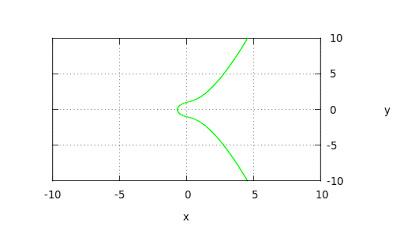Elliptic Curve
Elliptic curve is an equation with two variables and coefficients and it is a cubic equation like the following form:
\(y^{2}+axy+by=x^{3}+cx^{2}+dx+e\)
\(y^{2}=x^{3}\)
Let’s plot \(y^{2}=x^{3}+ax+b\) with set of points E(a,b) = E(1,1)

First we have element called O (zero point or point of infinity) and we have a rule in geometric tearm “If 3 points on an elliptic curve lie on a straight line, their sum is O.”
We can drive some rules from this rule :
1- For any point P on elliptic curve P+O=P.
2- The negative of point P with the same X coordinate, so if P=(x,y) then -P=(x,-y).
3- To add two points P and Q,draw a straight line between them and the third intersection point with curve is -R, then these three points P+Q=-R and the positive value of P+Q is the mirror image of the third point.
If the line between P and Q is tangent to the curve then R=P or R=Q.
4- To double point P,draw the tangent line and find the intersection point S then 2P=-S.
1- To add two points
\(P({X}_{p},{Y}_{p}) \ Q({X}_{q},{Y}_{q})\), then the slope of the line that join them \(\Delta = \frac{{Y}_{q}-{Y}_{p}} {{X}_{q}-{Y}_{p}}\)
Then we can express R (which R= P+Q)
\({X}_{r} = \Delta ^{2} - {X}_{p}-{X}_{q}\)
\({Y}_{r} = -{Y}_{p}+\Delta({X}_{p}-{X}_{r})\)
2- To double point P P+P=2P = R
\({X}_{r} =(\frac{3{X}_{p}^{2}+a}{2{Y}_{p}})^{2}-2{X}_{p}\)
\({Y}_{p} =(\frac{3{x}_{p}^{2}+a} {2{Y}_{p}})({X}_{p}-{X}{r})-{Y}_{p}\)
Elliptic Curve over finite field is using elliptic curve in which variables and coefficients are all restricted to elements of finite field.
Prime Curve is using a cubic equation in which the variables and coefficients take value from 0 to P-1.
Equation of elliptic curve over Zp = \(y^{2} mod(p)=(x^{3}+ax+b) mod(p)\)
1- If \(P({X}_{p},{Y}_{p}) \ then \ -P({X}_{p},{-Y}_{p})\).
2- To add two points \(P({X}_{p},{Y}_{p}) \ and \ Q ({X}_{q},{Y}_{q}) \ R= P+Q\)
Then R = \({X}_{r}=(\lambda^{2}-{X}_{p}-{X}_{q})mod(p)\)
\({Y}_{r}=(\lambda({X}_{p}-{X}_{r})-{Y}_{p})mod(p)\)
\(\lambda = \begin{cases}(\frac{{}{Y}_{q}-{Y}_{p}}{{X}_{q}-{X}_{p}})mod(p)) & if\ p\neq q \\ \\ (\frac{3{X}_{p}^{2}+a}{2{Y}_{p}})mod(p) & \text if \ p=q (double\ point\ p) \end{cases}\)
Example:
Let P=(3,10) Q=(9,7) in \({E}_{23}(1,1)\)
\(\lambda=\frac{7-10}{9-3}mod(23)\ =\frac{-1}{2}mod(23)=11\)
\({X}_{r}=(11^{2}-3-9)mod(23=13\)
\({Y}_{r}=(11(3-17)-10)mod(23)=20\)
Then P+Q = (17,20)
To double point P 2P
Example:
Let P =(3,10)
\(\lambda=(\frac{3(3^{2})+1}{2*10})mod(23)=6\)
\({X}_{r}=(6^{2}-3-3)mod(23)=7\)
\({Y}_{r}=(6(3-7)-10)mod(23)=12\)
Then 2P = (7,12)
\(GF(2^{m})\) consists of \(2^{m}\) elements with addition and multiplication can be defined over polynomials, which variables and coefficients are elements of \(GF(2^{m})\).
The cubic equation for cryptographic applications for elliptic curve can take the following form :
\(y^{2}+xy= x^{3}+ax^{2}+b\)
Example:
For g = 0010
\(y^{2}+xy=x^{3}+g^{4}x^{2}+1 \ \ \ where \ a=g^{4} ,b=g^{0}\)
\(a= g^{4}, b = 1\) and points that satisfies this equation \((g^{5},g^{3})\)
\(=(9^{3})^{2}+(9^{5})(9^{3})=(9^{5})^{3}+(9^{4})(9^{5})^{2}+1\)
\(=9^{6}+9^{8}=9^{15}+9^{14}+1\)
1100+0101 = 0001+1001+0001
1001 = 1001
1- If \(P({X}_{p},{Y}_{p}) and Q({X}_{q},{Y}_{q}) R = P+Q\)
Then
\({X}_{r}=\lambda^{2}+\lambda+{X}_{p}+{X}_{q}+a\)
\({Y}_{r}=\lambda({X}_{p}+{X}_{r})+{X}_{r}+{Y}_{p}\)
\(\lambda=(\frac{{Y}_{q}+{Y}_{p}}{{X}_{q}+{X}_{p}})\)
2- If \(P({X}_{p},{Y}_{p}) R = 2P\)
\({X}_{r}=\lambda^{2}+\lambda+a\)
\({Y}_{r}={X}_{p}^{2}+(\lambda+{X}_{p})\)
\(\lambda={X}_{p}+\frac{{Y}_{p}}{{X}_{p}}\)
First choose a large integer q OR a prime number P or integer of form \(2^{m}\)
Then choose base point \(G =({x}_{1},{x}_{2})\) in Ep(a,b) whose order is a very large value n, The order n of point G is the smallest positive integer n such that nG=0.
The Key exchange can be done by the following:
1- User A select an integer \({n}_{A}\) less than n , This is A’s private key, then compute public key \({P}_{a}={n}_{A} * G\)
2- User B select \({n}_{B}\) and compute the public key \({P}_{b}\)
3- User A compute the secret key \(K={n}_{A} * {P}_{b}\)
4- User B compute the secret key \(K={n}_{B} * {P}_{a}\)
Note 1: The secret key is a pair of numbers.Example:
P=211 in Ep(0,-4)
The equation \(y^{2} = x^{3} - 4\)
G = (2,2)
A’s private key \({n}_{A}=121\)
B’s private key \({n}_{B}=203\)
Then
A’s public key \({P}_{a}={n}_{A} * G = 121(2,2) = (115,48)\)
B’s public key \({P}_{b}={n}_{B} * G = 203(2,2) = (130,203)\)
A’s secret key \(K={n}_{A} * {P}_{b} = 121(130,203) = (161,69)\)
B’s secret key \(K={n}_{B} * {P}_{a} = 203(115,48) = (161,69)\)
Then the shared key k = (161,69)
First we have to encode the message to be sent as x and y coordinates, and it is not easy because not all points are in \({E}_{p}(a,b)\).
As with the key exchange
- Choose a point G
- User A select a private key \({n}_{A}\)
- User A calculate the public key \({P}_{a}={n}_{A} * G\)
To send a message Pm to User B, User A choose a random integer K and then produce the ciphertext Cm by the following: \({C}_{m} = (KG.{P}_{m} + K{P}_{b})\)
Note 2: User A masked the message Pm by adding (K.Pb) and nobody but user A knows k value.Example:
P=751 in \({E}_{p}(-1,188)\)
The equation \(y^{2} = x^{3} -x + 188\)
G=(0,376) Pm = (562,201)
User A choose k=386
\({P}_{b} = (201,5)\)
Then K.G = 386(0,376) = (676,558)
\({P}_{m} + K,{P}_{b}\)
(562,201) + 386(201,5) = (385,328)
Then the ciphertext Cm
Cm = {(676,558),(385,328)}